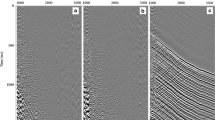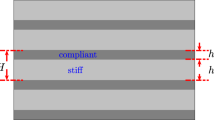Abstract
In seismic sections, the presence of a gas hydrate stability zone (GHSZ) is often marked by a bottom-simulating reflector, which has a negative polarity with respect to the seafloor. The present study reveals the response of seismic wave characteristics and amplitude versus offset (AVO) effects of large offset compressional (P) and converted (PS) waves for a GHSZ/free-gas configuration, using a two-dimensional elastic anisotropic modelling technique. The modelling results would provide ‘a priori’ information, which allows unique determination of parameters of seismic models for the design of ocean bottom seismometer experiments over continental margins for the purpose of gas hydrate exploration. The AVO analyses on long offset P and PS waves based on synthetic data yield a typical gas hydrate/free-gas response, as the reflectivity increases with incidence angle.





Similar content being viewed by others
References
Alfaraj M (1993) Transformation to zero offset for mode-converted waves. PhD Thesis, Colorado School of Mines, CO
Baker LJ (1989) Is 3-D wave equation modeling feasible in the next ten years? In: Eisner E (ed) Supercomputers in seismic exploration. Pergamon Press, New York, Handbook of Geophysical Exploration, Sect. I, pp 21
Carcione JM, Tinivella U (2000) Bottom simulating reflectors: seismic velocities and AVO effects. Geophysics 65(1):54–67
Castagna JP, Batzle ML, Eastwood RL (1985) Relationship between compressional-wave and shear wave velocities in elastic silicate rocks. Geophysics 50:571–581
Castagna JP, Batzle ML, Tubman KM, Gaiser JE, Burnett MD (1993) Offset-dependent reflectivity—theory and practice of AVO analysis. In: Castagna JP, Backus MM (eds) Investigations in geophysics. SEG Publication Co, Denver, CO, pp115–135
Christeson GL, McIntosh KD, Shipley TH (2000) Seismic attenuation in the Costa Rica margin wedge: amplitude modeling of ocean bottom hydrophone data. Earth Planet Sci Lett 179:391–405
Crampin S (1981) A review of wave motion in anisotropic and cracked elastic media. Wave Motion 3:343–391
Crampin S (1984) Effective anisotropic elastic constants for wave propagation through cracked solids. Geophys J R Astron Soc 76:135–145
Crampin S, Lovell JH (1991) A decade of shear-wave splitting in the Earth’s crust: what does it mean? what use can we make of it? and what should we do next? Geophys J Int 107:387–407
Digranes P, Mjelde R, Kodaria S, Shimamura H, Kanasawa T, Shiobara H, Berg EW (1996) Modelling shear waves in OBS data from the Voring Basin (northern Norway) by 2D ray tracing. PAGEOPH 147(4):611–629
Domenico SN (1977) Elastic properties of unconsolidated porous sand reservoir. Geophysics 42:15–24
Ecker C, Dvorkin J, Amos N (1998) Sediments with gas hydrates: internal structure from seismic AVO. Geophysics 63(5):1659–1669
Gaiser J, Moldoveanu N, Macbeth C, Michelena R, Spitz S (2001) Multicomponent technology: the players, problems, applications, and trends: summary of the workshop sessions. Leading Edge 20(9):1042–1047
Huffman AR, Castagna JP (2001) Petrophysical basis for shallow-water flow prediction using multicomponent seismic data. Leading Edge 20(9):1030–1035
Hyndman RD, Spence GD (1992) A seismic study of methane hydrate marine bottom simulating reflectors. J Geophys Res 97:6683–6698
Jarchow CM, Catchings RD, Lutter WJ (1994) Large explosive source, wide recording aperture, seismic profiling on the Columbia Plateau, Washington. Geophysics 59:259–271
Katzman R, Holbrook WS, Paull CK (1994) Combined vertical-incidence and wide-angle seismic study of gas hydrate zone, Blake Ridge. J Geophys Res 99:17975–17995
Kim SD, Nagihara S, Nakamura Y (2000) P- and S-wave velocity structures of the Sigbee abyssal plain of the Gulf of Mexico from ocean bottom seismometer data. Gulf Coast Assoc Geol Soc (GCAGS) Trans 50:475–484
Kopp H, Klaeschen D, Flueh ER, Bialas J (2002) Crustal structure of Java margin from seismic wide angle and multichannel reflection data. J Geophys Res 107(B2):1–24
Lynn HB, Simon KM, Bates CR, Layman M, Schneider R (1995) Seismic characterization of a naturally fractured gas reservoir. In: Extended abstract volume 59th international meet society exploration geophysicists, 10–15 November 1996. Denver, CO, pp1360–1363
Mikhailov O, Johnson J, Shoshitaishvili E, Frasier C (2001) Practical approach to joint imaging of multicomponent data. Leading Edge 20(9):1016–1021
Satyavani N, Uma S, Thakur NK, Reddi SI (2002) Probable gas hydrate/free gas model over western continental margin of India. Mar Geophys Res 23(5/6):423–430
Shipley TH, Houston MH, Buffler RT, Shaub FJ, McMillen KJ, Ladd JVV, Worzel JL (1979) Seismic reflection evidence for widespread occurrence of possible gas hydrate horizons on continental slops and rises. AAPG Bull 63:2204–2213
Thomsen L (1986) Weak elastic anisotropy. Geophysics 51:1954–1966
Thomson L (1988) Reflection seismology over azimuthally anisotropic media. Geophysics 51:304–313
Thomson L (1999) Converted-wave reflection seismology over inhomogeneous, anisotropic media. Geophysics 64(3):678–690
Thomsen L, Barkved O, Haggard B, Kommedal J, Rosland B (1997) Converted wave imaging of Valhall reservoir. In: Extended abstract volume 59th meet European association of geophysical exploration, 26–30 May 1997, vol B048. Geneva, pp477–480
Tinivella U (1999) A method to estimate gas hydrate and free gas concentrations in marine sediments. Boll Geofis Teor Appl 40:19–30
Tsvankin I, Thomson L (1994) Nonhyperbolic reflections move out in anisotropic media. Geophysics 59:1290–1304
Walther CHE (2003) The crustal structure of the Cocos ridge off Costa Rica. J Geophys Res 108(B3):2136
Winterstein DF (1990) Velocity anisotropy terminology for geophysicists. Geophysics 55:1070–1088
Winterstein DF, Meadows MA (1991) Changes in shear-wave polarization azimuth with depth in Cymric and Railroad oil fields. Geophysics 56:1349–1364
Acknowledgements
We would like to thank Dr. V.P. Dimri, Director, NGRI, for permission to publish the results of this study. We are very grateful to an anonymous reviewer for constructive comments, which helped us to improve the manuscript. We would also like to acknowledge the unflagging support of and discussions with S.I. Reddi.
Author information
Authors and Affiliations
Corresponding author
Rights and permissions
About this article
Cite this article
Rajput, S., Rao, P.P. & Thakur, N.K. Two-dimensional elastic anisotropic/AVO modelling for the identification of BSRs in marine sediments using multicomponent receivers. Geo-Mar Lett 25, 241–247 (2005). https://doi.org/10.1007/s00367-005-0212-7
Received:
Accepted:
Published:
Issue Date:
DOI: https://doi.org/10.1007/s00367-005-0212-7




